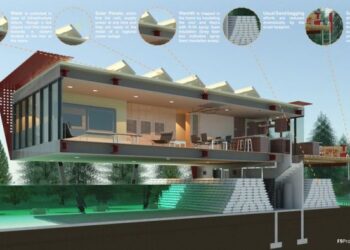Exploring the world of Building Envelope Mistakes That Lead to Leaks, this introduction sets the stage for an informative journey filled with insights and valuable knowledge.
In the following paragraphs, we will delve into the common errors, material selection challenges, installation mishaps, and maintenance practices that can impact the integrity of a building's envelope.
Common Mistakes in Building Envelope Design

When it comes to building envelope design, certain mistakes can compromise the integrity of the structure and lead to potential leaks. It is crucial to pay attention to key design errors to ensure the longevity and durability of the building.
Overlooking Proper Insulation
Proper insulation is essential in preventing heat loss and maintaining a comfortable indoor environment. When insulation is overlooked or not installed correctly, it can lead to thermal bridging, condensation issues, and ultimately, leaks. Insufficient insulation can also result in higher energy bills as the building struggles to maintain a consistent temperature.
Impact of Poor Waterproofing Techniques
Waterproofing is a critical aspect of building envelope design, as water infiltration can cause significant damage over time. Poor waterproofing techniques, such as improper flashing, inadequate sealants, or faulty membranes, can result in water seepage, mold growth, and structural deterioration.
It is essential to prioritize proper waterproofing to protect the building from moisture-related issues and maintain its structural integrity.
Materials Selection and Compatibility
When it comes to the building envelope, selecting compatible materials is crucial in ensuring its integrity and preventing leaks. Mismatched materials can lead to issues such as water infiltration, air leakage, and overall reduced durability of the structure.
Examples of Commonly Mismatched Materials
- Using different types of metal that can cause galvanic corrosion when in contact with each other.
- Combining materials with different rates of expansion and contraction, like concrete and steel, which can lead to cracking and water penetration.
- Pairing materials with varying levels of permeability, such as a vapor-impermeable material with a vapor-permeable one, disrupting the building's ability to manage moisture.
Impact of Material Expansion and Contraction
Material expansion and contraction due to temperature changes can compromise the building envelope's integrity. For instance, if a material expands more than its adjacent material, it can create gaps or cracks where water can infiltrate, leading to leaks and potential structural damage.
Installation Errors and Their Consequences

Improper installation practices can have serious consequences when it comes to the building envelope. Leaks can occur due to a variety of mistakes made during the installation process, compromising the integrity of the structure.
Improper Sealing Techniques
- Failure to properly seal joints and connections can lead to water infiltration, resulting in leaks.
- Using incorrect sealant materials or applying sealants incorrectly can also contribute to leakage issues.
- Improperly sealed windows and doors are common culprits for water penetration, causing damage to the building envelope.
Improper Flashing Installation
- Improper flashing installation around windows, doors, and other openings can create pathways for water to enter the building envelope.
- When flashing is not installed correctly or is missing altogether, it can allow water to seep into the walls, leading to leaks and potential structural damage.
- Flashing should be installed in a continuous and watertight manner to ensure proper protection against moisture intrusion.
Maintenance Practices for Preventing Leaks
Regular maintenance of the building envelope is crucial in preventing leaks and avoiding costly repairs. By implementing best practices for routine upkeep, property owners can ensure the longevity and integrity of their structure. Proactive maintenance involves inspecting the envelope for potential issues and addressing them promptly before they escalate into major problems.
Step-by-Step Guide for Inspecting the Envelope
- Start by visually examining the exterior of the building, looking for any signs of damage such as cracks, gaps, or missing caulking.
- Check the roof for any missing or damaged shingles, flashing, or other components that could compromise the envelope's integrity.
- Inspect windows and doors for proper seals, weatherstripping, and functioning mechanisms to prevent water infiltration.
- Examine the foundation for cracks, settling, or drainage issues that may affect the building envelope.
- Regularly clean gutters and downspouts to ensure proper water drainage away from the structure.
Role of Proactive Maintenance in Leak Prevention
Proactive maintenance plays a key role in preventing leaks by identifying and addressing potential issues before they lead to water damage. By conducting regular inspections and promptly addressing any issues, property owners can save time and money in the long run.
Additionally, proactive maintenance helps extend the lifespan of the building envelope and ensures the safety and comfort of occupants.
Wrap-Up
In conclusion, understanding and avoiding these mistakes can greatly enhance the longevity and performance of a building's envelope. By applying the insights gained from this discussion, one can ensure a leak-free and resilient structure for years to come.
Key Questions Answered
How important is proper insulation in preventing leaks?
Proper insulation is crucial as it helps maintain temperature control and prevents moisture buildup that can lead to leaks.
What are some common installation mistakes that can result in leaks?
Common installation errors include improper sealing, inadequate flashing, and using incompatible materials.
Why is routine maintenance essential for preventing leaks?
Routine maintenance helps identify potential issues early on, allowing for timely repairs and preventing costly leaks in the long run.









